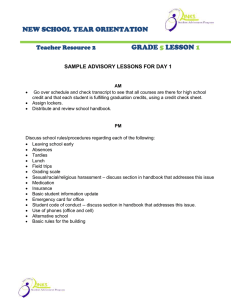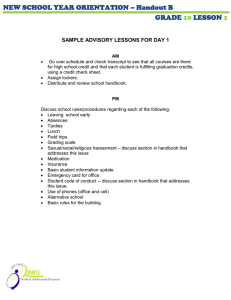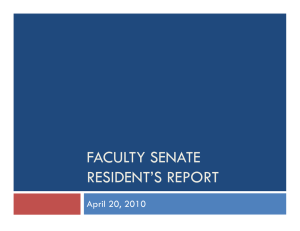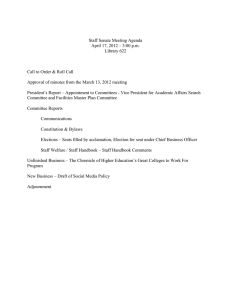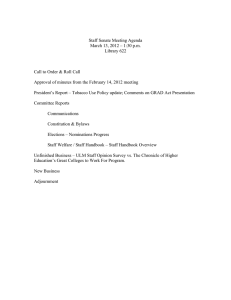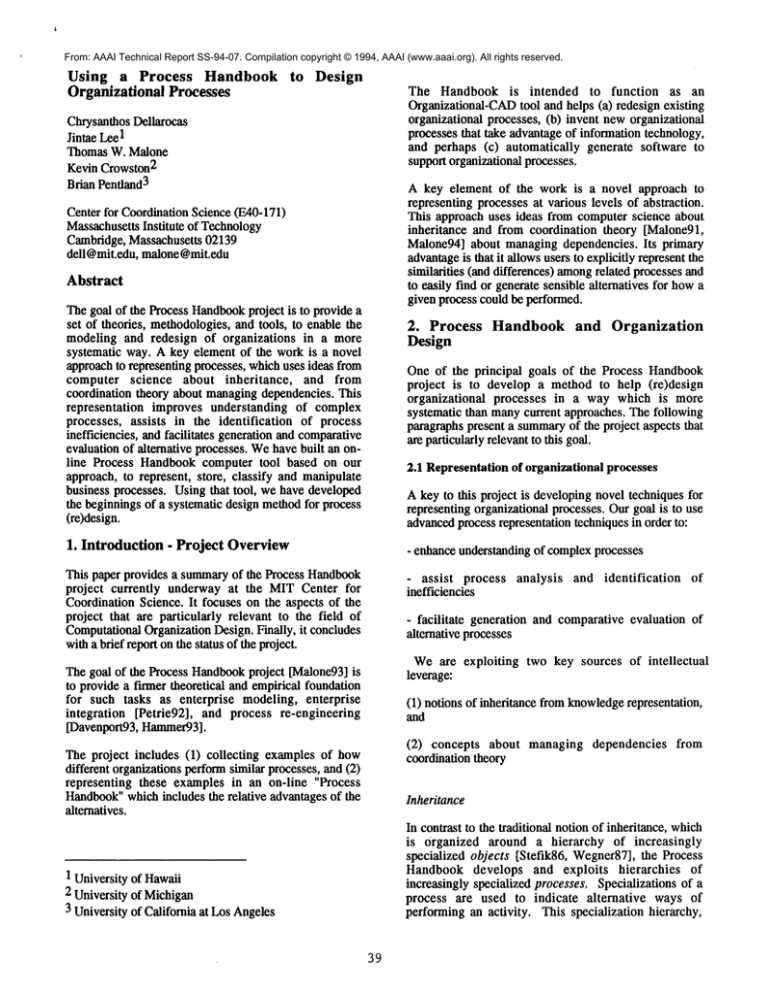
From: AAAI Technical Report SS-94-07. Compilation copyright © 1994, AAAI (www.aaai.org). All rights reserved.
Using a Process
Handbook
Organizational Processes
to
Design
The Handbook is intended to function as an
Organizational-CAD
tool and helps (a) redesign existing
organizational processes, (b) invent neworganizational
processesthat take advantageof informationtechnology,
and perhaps (c) automatically generate software
supportorganizationalprocesses.
ChrysanthosDellarocas
Jintae Leel
Thomas W. Malone
2Kevin Crowston
3Brian Pentland
Center for CoordinationScience(EA0-171)
MassachusettsInstitute of Technology
Cambridge,Massachusetts02139
dell@mit.edu, malone@mit.edu
Abstract
Thegoal of the Process Handbook
project is to provide a
set of theories, methodologies,and tools, to enablethe
modeling and redesign of organizations in a more
systematic way. A key element of the workis a novel
approachto representingprocesses, whichuses ideas from
computer science about inheritance,
and from
coordination theory about managingdependencies. This
representation improves understanding of complex
processes, assists in the identification of process
inefficiencies, andfacilitates generationandcomparative
evaluationof alternative processes.Wehavebuilt an online Process Handbookcomputer tool based on our
approach,to represent, store, classify and manipulate
business processes. Usingthat tool, wehave developed
the beginningsof a systematicdesign methodfor process
(re)design.
A key element of the work is a novel approach to
representing processesat various levels of abstraction.
This approach uses ideas from computerscience about
inheritance and from coordination theory [Malone91,
Malone94]about managingdependencies. Its primary
advantage
is that it allowsusers to explicitly representthe
similarities (and differences) amongrelated processesand
to easily find or generatesensible alternatives for howa
given process could be performed.
2. Process Handbook and Organization
Design
One of the principal goals of the Process Handbook
project is to develop a method to help (re)design
organizational processes in a way which is more
systematic than manycurrent approaches. Thefollowing
paragraphspresent a summary
of the project aspects that
are particularlyrelevantto this goal.
2.1 Representation
of organizationalprocesses
A key to this project is developingnovel techniquesfor
representingorganizationalprocesses. Ourgoal is to use
advancedprocessrepresentationtechniquesin order to:
1. Introduction- Project Overview
- enhanceunderstandingof complexprocesses
This paper provides a summaryof the Process Handbook
project currently underway at the MITCenter for
CoordinationScience. It focuses on the aspects of the
project that are particularly relevant to the field of
Computational
OrganizationDesign.Finally, it concludes
witha brief report onthe status of the project.
- assist process analysis and identification
inefficiencies
The goal of the Process Handbook
project [Malone93]is
to provide a framertheoretical and empirical foundation
for such tasks as enterprise modeling, enterprise
integration [Petrie92], and process re-engineering
[Davenport93,Hanuner93].
The project includes (1) collecting examples of how
different organizationsperformsimilar processes,and(2)
representing these examples in an on-line "Process
Handbook"
whichincludes the relative advantagesof the
alternatives.
of
- facilitate generation and comparativeevaluation of
alternative processes
Weare exploiting two key sources of intellectual
leverage:
(1) notions of inheritance fromknowledge
representation,
and
(2) concepts about managing dependencies from
coordinationtheory
Inheritance
In contrast to the traditional notionof inheritance, which
is organized around a hierarchy of increasingly
specialized objects [Stefik86, Wegner87],the Process
Handbook develops and exploits hierarchies of
increasingly specialized processes. Specializations of a
process are used to indicate alternative ways of
performingan activity. This specialization hierarchy,
1 University of Hawaii
2 University of Michigan
3 Universityof California at Los Angeles
39
whencombinedwith the usual decompositionhierarchy
of a process, produces a powerful mechanismfor
systematicallyexploringnewalternatives.
Facilitated comparison
and evaluationof alternatives. By
explicitly representing alternative processes and their
relative strengths andweaknesses,the task of selecting
appropriateprocessesis facilitated.
Figure 1 shows an exampleof howdecomposition and
specialization can worktogether using the preliminary
representational schemewehavedeveloped.
In this figure, the genericactivity of "Sellinga product"is
decomposed
into subactivities like "Identify prospects"
and "Inform prospects about product". The generic
activity is also specializedinto morefocusedactivities
like "Direct mall sales" and "Retail storefront sales".
Thesespecialized activities automatically inherit the
subactivities and other characteristics of their "parent"
process. In some cases, however, the specialized
processesaddto or changethe characteristicstheyinherit.
For instance, in direct mail selling, the subactivities of
obtainingan order anddelivering a productare inherited
without modification. But identifying prospects is
replaced by the morespecialized activity of obtaining
mailinglists, andthe sales persontalking to prospectsis
omittedaltogether.
Enhancedretrieval, combination, and generation of
relevant alternatives. Depending
on their goals, users of
the systemcan browseat various levels of abstraction,
finding alternatives that are related according to the
principles embodiedin the specialization structure. For
instance, merelycollecting descriptions of howdifferent
companiessell consulting services, would probably
identify numerousexamplesof direct sales and perhaps
mail advertising techniques. But the specialization
hierarchy weproposewouldquickly lead users whowere
interested in moreradical alternatives to consideroptions
like retail storefrontselling, evenif no casesof consulting
firms using this methodhad been observed. Thus, the
systemhelps users generate newalternatives by creating
newspecializations of alternatives at higher levels of
abstraction.
These techniques of decomposition and alternative
specializationcan, of course,be usedfor activities at any
level. For instance, Figure 1 showsthat "Obtainmailing
lists" can be further decomposed
and "Informprospects
about product"can be specialized into "Advertising"or
"Sales person talks to prospects". In general, weuse
decomposition to indicate "and" relationships, and
specializationto indicate"or" relationships.
CoordinationTheory
Even though the examples in Figure 1 only showone
"parent"for the activitiesthat are specializations,it is also
often useful to havemultipleinheritancein whicha single
activity is a specializationof severalparents.In that case,
the activity inherits the unionof decompositions
of all
parents. For example,"TVads" mightbe a specialization,
not only of "Advertising", but also of "TVbroadcasts",
and it might, therefore, inherit subactivities or other
characteristicsfrombothof these parents.
The productioncomponent
includes the process activities
that are physically or logically necessaryto achievethe
stated goals of the process. The coordinationcomponent
consists of the activities necessaryto properlymanage
the
dependenciesamongproductionactivities.
Thesecond key concept is the notion from coordination
theory that coordination processes can be thought of as
ways of managing dependencies among activities
[Malone91,Malone93].Organizational processes can be
viewedas containing both production and coordination
components.
Our process representation clearly decouples the two
components
by identifying the productionsteps explicitly,
and then associating the coordination steps with the
underlying dependenciesthat makethemnecessaryin the
first place.
Advantagesof processinheritance:
This method of representing processes using a
combination of decomposition and alternative
specializations has a numberof significant benefits over
traditional processrepresentationtechniques.
In Figure1, only the basic productionsubactivities of the
"Sell Product"process appear explicitly. Coordination
activities, such as customerorder processing, product
inspection and shipping, and paymenttracking, do not
appear in the picture, but are "hidden" behind
dependenciesthat makethat coordination necessary. For
exampleorder processing, inventory management,order
inspectionandshipping,are all subactivitiesof onewayof
managingthe Producer/Consumerdependency between
"Obtain order" and "Deliver product". Alternative
specializations of the Sales process maycontain a
completelydifferent set of coordination activities to
managethe same dependency.
Easier representation of new processes. By simply
identifyinga moregeneralprocessthat the newprocessis
intendedto specialize, muchof the informationabout the
newprocess can be automaticallyinherited and only the
changesneedto be explicitly entered.
Simplified maintenance of families of process
descriptions. Changesmadeat a high level can be
automaticallypropagatedto morespecialized processes,
thus allowingeasy andconsistent maintenance
of a large
numberof related processdescriptions.
It is possible that a given activity maybe viewedas a
productionand as a coordination component
at different
40
%
J~
.<
.-ID,
0I~°
.<
e~
o
c~
.<
Q
/41
Dependency
Examplesof coordination processes for managing
dependency
Sharedresources
"First come/first serve", priority order, budgets,
managerialdecision, market-likebidding
Task assignments
Producer/ consumerrelationships
Prerequisiteconstraints
Inventory
(sameas for "Sharedresources")
Notification,sequencing,tracking
Inventory management(e.g., "Just In Time",
"EconomicOrder Quantity")
Standardization,ask users, participatorydesign
Concurrentengineering
Scheduling,synchronization
Goalselection, task decomposition
Usability
Designfor manufacturability
Simultaneityconstraints
Task/ subtask
Table1.
Examplesof common
dependenciesbetweenactivities and alternative coordination
processesfor managing
them.(Indentationsin the left columnindicate morespecialized
versions of general dependency
types.)
times. For example, writing a manual may be a
production componentof the documentationprocess, but
a coordination process that managesthe usability
dependency in the overall context of a product
developmentprocess. Webelieve, however, that the
distinction betweenproductionand coordinationis always
usefulwhenthe contextof analysisis fixed.
resources in general can be specialized to apply to task
assignment.
Weare testing the hypothesis that most coordination
processesencounteredin practice are alternative waysof
managinga relatively small set of dependencytypes.
Fromthis perspective, wecan build a taxonomy
of basic
dependencytypes and associate each dependencytype
with a specializationhierarchyof alternative coordination
processes for managingit. Furthermore,it seemsthat
manycoordinationprocessesare applicableacross a large
range of functional domains.For example,a coordination
process used to managea dependencyin a manufacturing
process, maybe used intact or with minormodifications
to managea similar dependency
in a finance process.
Advantagesof activity-dependencyrepresentation:
By identifying various types of dependenciespossible
between activities and the associated coordination
processes for managingthem, webelieve we will obtain
several representationalbenefits in the ProcessHandbook.
Twoof the mostimportantbenefits are: enhancedprocess
understanding
and generativity.
Table1 suggests the beginningsof such an analysis. The
table shows a set of commondependencies between
activities, together with examples of alternative
coordinationprocessesused to managethem.
Note that dependency types themselves form a
specialization hierarchy, with more specific types
inheriting (and possiblyspecializing) the set of managing
processes of more general dependency types. For
instance, task assignmentcan be seen as a special case of
allocating sharedresources. In this case, the "resource"
beingallocatedis the time of peoplewhocan do the tasks.
This impliesthat the coordinationprocessesfor allocating
42
Figure2 showshowa subset of alternative processesfor
managinga prerequisite dependencycould be organized
into a specialization hierarchy and integrated in the
Process Handbook.
Abstraction enhances understanding. Coordination
activities are often relatively "low-lever’(e.g. "Complete
requisition form", "Ship packet by courier", etc.),
comparedto the production activities whosedependency
they manage.Traditional process representations, which
mixproduction and coordination activities in the same
picture, very fast becomecluttered with detail. This
hinders understandingthe essence of the process, as well
as the purpose of coordination activities. Separating
coordination activities and "hiding" them behind
dependencies,results in simpler representations, which
highlight the essence of a process. In addition, it
associates coordinationactivities with their underlying
dependencies.Thus,the purpose(or lack thereof) for each
coordinationactivity is madeclear.
I
Ililllil
I
Ilili
I
illllli
Prerequisite
managen~t [
|
illl~
illli
I
lie
#..........
mL~
Deaermine
when
prerequisites
satisfied for
activity
I
Used.
I system
illllli
V
i
I
] Ionttysyst©m
I
i
"V........,
T.........,",
Find all cases
J
Find status [I
of specific
with specific
II
Find all ca.qcs
that are
I
,
:I
i
!
I
I
Enter
: ..............
i
I
I
I
I
I
.,
I
I
÷,÷
l~
Print
packing
list
Print orders
awaiting
l~yment
Figure 2. Alternative coordination processes for managinga prerequisite dependency.
Dependencies enhance generativity.
As we mentioned
earlier,
each dependency type is connected to a
specialization hierarchy of alternative coordination
processes for managingit. The association of an existing
coordination process with its underlying dependency, not
only improves understanding of the business process
under study, but also provides immediateaccess to a large
number of alternative
ways of performing that
coordination, extracted from business processes in many
different domains.This helps produceideas for generating
improvedalternatives for the studied process.
2.2 A coordinaUon-theory-based method for process
(re)design
The synergy of the two novel aspects of our process
representation (process inheritance and coordination
theory) is especially important in the capture, analysis and
redesign phases of an existing process. Our approach
suggests the beginnings of a systematic design methodfor
capturing and analyzing existing business processes and
for generating new ones. The method is based on the
coordination theory representation of processes and
consists of the followingsteps:
information about the new process can be automatically
inherited.
Hence, mapping of new processes can
sometimes be an incremental refinement of previously
stored models, rather than an exercise that has to begin
from scratch each time.
b. Analyze existing processes
-Separate production activities
from coordination
activities of existing process. Given an initial mapof a
business process, identify which activities capture the
"essence" of the process, and which are simply there to
manage dependencies among production activities.
Although this step requires human judgment and
experience, comparison with mapsof "similar" processes
already stored in the Process Handbook, for which the
separation has already been performed, can often provide
significant help. Weare developinga set of guidelines and
heuristics that will help analysts perform this step with
accuracy and consistency.
-Identify underlying dependencies being managed by
each coordination activity. Replacecoordination activities
with their underlying dependencies. This step produces an
activity-dependency
view which is uncluttered
by
coordination details and captures what is, in somesense,
the essence of a process. We believe that this
representation helps analysts gain insight into the
coordination requirements of the process, as well as
identify latent dependencies amongproduction activities
which may not be addressed in the existing process.
Again, comparison with the maps of "similar" processes
can assist in performingthis step efficiently.
a. Captureexisting processes
The first phase in any process redesign project usually
consists of capturing the existing situation. Our methodof
representing
processes using a combination of
decomposition and alternative specializations
can
substantially reduce the amount of work necessary for
process capture. By identifying a previously stored
process that the target process is "similar" to, muchof the
43
-Identify unmanageddependencies, poorly managed
dependencies,and unnecessarycoordinationactivities.
Manyprocess inefficiencies can be traced back to
missing, poor, or redundantcoordination processes. By
separating coordination processes and isolating them
behind their underlying dependencies, they can be
individually examined
in a systematicway.
c. Generatealternative processes
- Redesignproductioncomponent
of existing process. Use
the specialization hierarchy of the process handbookto
comparethe existing process with possible alternatives
and generate ideas about possible improvements.
- Redesign coordination process for each dependency.
Use the coordination process specialization hierarchy
associated with each dependencytype to generate ideas
for possibly better ways of achieving the desired
coordination. Since coordination processes for a given
dependency type are collected from manydifferent
contexts, this step enables experiencegainedin possibly
very different domainsto be used in improving the
processunderstudy.
Combineproduction and coordination activities to
generate newprocess. Replaceeach dependencywith its
chosen managing process. Combineproduction and
coordinationactivities to producea descriptionof the new
process which might be fed to a workflowgenerator,
executedby a computersystem,or givento peopleas a set
of job descriptions (Weare workingtowardsautomating
this step).
Theabove design process reduces the complexityof the
analysis and synthesis task by identifying simplerdesign
subtasks in a systematic way.Furthermore,by arranging
processes in a specialization hierarchy, the process of
finding, comparing, and selecting relevant stored
alternatives is greatly enhanced. For example, the
specialization hierarchy helps identify, not only
alternative processes in similar domains, but also
analogousprocessesin very different domains.Finally,
the decomposition structure of processes allows
recombinationof previously stored process segmentsto
generateentirely newdesigns.
2.3. A Process Handbook
as an organizational-CAD
tool
Traditional CADtools have transformedthe process of
engineering design, reducing the cycle time of new
designs and improvingtheir reliability and accuracy.We
believe that the process of organization design can be
similarly transformedby the use of Organizational-CAD
tools. Animportantgoal of this project is to developa
Process Handbookcomputer tool that supports our
representation techniques and the evolving design
methodologypresented in the previous section. More
specifically, our Process Handbookprovides (or will
provide)supportin the followingareas:
Process representation and storage. The most basic
requirement from a Process Handbookis to support a
processontologybasedon our representationideas and to
allow easy graphical entry, editing, and viewing of
processdata, automaticprocessinheritance, andefficient
storageof processes.
Navigationand retrieval. Thesystem should also allow
users to navigate within the process specialization
hierarchyand easily retrieve stored processesthat match,
or are "similar" to, a set of criteria using a variety of
different ways. The Process Handbookconveniently
places "similar" processes close together in the
specialization hierarchy andsupports navigation using a
graphical browser.In addition, desired processes can be
located using keywordmatching. Weare experimenting
with other waysof processretrieval, basedon comparing
structural or behavioralattributes of processes.
Evaluationof alternative processes. Ourprototypesystem
allowscollecting sets of "similar" processesunderbundles
and then comparing those processes using tradeoff
matrices. Tradeoffmatrices display a selected subset of
attributes for each processin the bundle.As in the Sibyl
system [Lee90], tradeoff matrices can also include
detailed justifications for the various settings. In the
future, our system will support additional evaluation
capabilities, such as dynamic
simulation.
Generationof newprocesses. The Process Handbook
can
function as a design whiteboard, to allow graphical
editing of existing processes, or creation of completely
newprocesses. Processes thus created can be compared
and evaluated with other stored processes, and either
permanentlystored in the specialization hierarchy or
discarded.
Translation of designs into enactableforms. Thesystem
will provide support for automatically translating a
process design from our coordination-theory
representationinto moredirectly enactable formats. Such
formats mayinclude sets of job descriptions (for manual
processes), workflowgenerator scripts, or maybeeven
softwareto drive arbitrary computer
systems.
Intelligent assistance. The systemwill allow users to
define various heuristics to be applied to stored or new
process designs. The ability to define and execute
heuristic algorithmsat the user level is very important,
since both our design methodologyand knowledgeabout
process designare currently evolving. Thus,the Process
Handbookbecomesa tool, not only for designing new
processes,but also for experimenting
with newprinciples
of processdesign. Heuristics couldbe helpful in locating
"similar" processes, identifying process inefficiencies,
evaluating candidate alternatives or generating new
alternatives.
3. Current Status
[Lee90] Lee J. Sibyl: A tool for managinggroup decision
rationale.
In ACMConference on Computer-Supported
Cooperative Work ( CSCW’90), Los Angeles, CA, 1990.
and Research Directions
Our project is currently progressing on several fronts:
- Weare continuing our development of coordination
theory, including an evolving taxonomy of dependency
types and corresponding coordination processes.
- Wehave developed a first version of our process
taxonomy,which currently includes over 500 processes.
- Wehave developed several prototype versions of the
Process Handbook.Our most recent version is built on top
of Kappa-PCand runs on PC-platforms. Weare currently
experimenting with several alternative environments for
our next implementation, including Lotus Notes.
- Weare developing a Process Interchange Format (PIF)
to facilitate the exchange of process representations
amongdifferent kinds of systems, such as the Process
Handbook, simulation tools, flowcharting tools, and
workflow systems.
- Finally, we have initiated a numberof field studies to
collect process data, test, and refine our methodologies
and approach.
If this research is successful, it will provide a set of
powerful intellectual tools and an extensive database to
help invent newkinds of organizations, improve existing
organizational processes, and, perhaps, automatically
generate software to enact those processes. It will also
contribute to developing a central part of coordination
theory: the understanding of generic coordination
processes and howthey occur in organizations. Finally,
we hope it will help us understand the possibilities that
information
technology provides for creating
organizations that are not only more effective, but also
morefulfilling for their members.
ACKNOWLEDGMENTS:
We would like to thank the
other members of the Process Handbook team, Fred
Luconi, Charlie Osborn, and George Wyner, for their
valuable contributions.
We would also like to
acknowledgethe financial support of the MITCenter for
Coordination
Science and the National Science
Foundation (grant #IRI-9224093).
References
[Davenport92] Davenport T.H. Process Innovation.
Harvard Business School Press: Boston, MA,1992.
[Hammer93] HammerM. and ChampyJ. Reengineering
the Corporation. Harper Business: NewYork, NY, 1993.
45
[Malone91]
Malone T.W. and Crowston K.G.
Towardan interdisciplinary theory of coordination, TR
#120, Massachusetts Institute of Technology, Center for
Coordination Science: Cambridge, MA,1991.
[Malone93]
Malone T.W., Crowston K., Lee J.,
Pentland B. Tools for inventing organizations: Towarda
handbookof organizational processes, In Proceedings of
the 2nd IEEE Workshop on Enabling Technologies
Infrastructure
for Collaborative
Enterprises,
Morgantown,WV,April 20-22, 1993.
[Malone94] Malone T.W. and Crowston K.G. The
interdisciplinary study of coordination, ACMComputing
Surveys, in print.
[Petrie92] Petrie C., Ed., Enterprise Integration
Modeling: Proceedings of the First International
Conference, MITPress: Cambridge MA,1992.
[Stefik86] Stefik M. and BobrowD.G. Object-oriented
programming: Themes and variations.
AI Magazine,
Spring 1986, pp. 40-62.
[Wegner87] Wegner P. Dimensions of object-based
language design. In Proceedings of the Conference on
Object-Oriented Systems, Languages and Applications
(OOPSLA
’87), pp. 168-182, Orlando, Fla., 1987: ACM.

